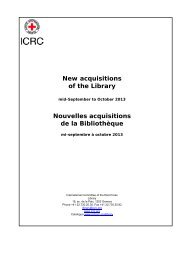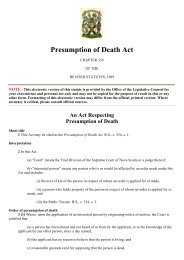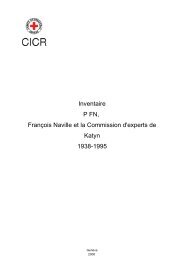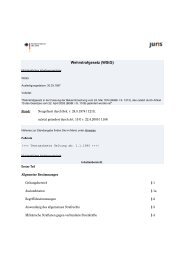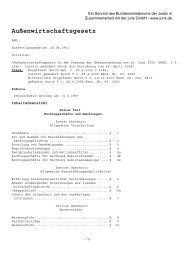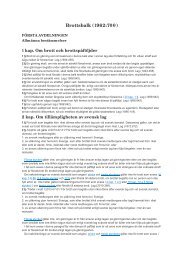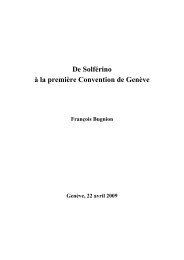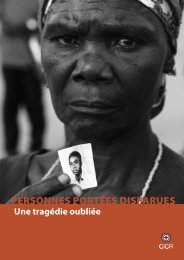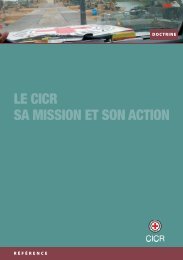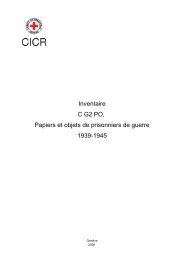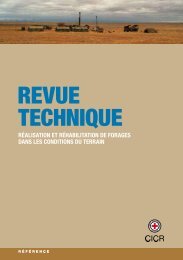Full text in PDF format - International Committee of the Red Cross
Full text in PDF format - International Committee of the Red Cross
Full text in PDF format - International Committee of the Red Cross
Create successful ePaper yourself
Turn your PDF publications into a flip-book with our unique Google optimized e-Paper software.
<strong>the</strong> use <strong>of</strong> laser weapons specifically<br />
designed to cause permanent bl<strong>in</strong>dness,<br />
as well as <strong>the</strong>ir transfer to any<br />
State or any o<strong>the</strong>r entity. The treaty<br />
fur<strong>the</strong>r provides that, <strong>in</strong> <strong>the</strong> employment<br />
<strong>of</strong> laser systems, <strong>the</strong> Contract<strong>in</strong>g<br />
Parties shall take all feasible precautions<br />
to avoid <strong>the</strong> risk <strong>of</strong> caus<strong>in</strong>g<br />
permanent bl<strong>in</strong>dness.<br />
This Protocol has been ratified by<br />
3 States, 1 <strong>of</strong> which are American<br />
States.<br />
Explosive Remnants <strong>of</strong> War<br />
The Protocol on Explosive Remnants<br />
<strong>of</strong> War (Protocol V), annexed<br />
to <strong>the</strong> Convention on Conventional<br />
Weapons <strong>in</strong> 2003, seeks to m<strong>in</strong>imise<br />
<strong>the</strong> perils aris<strong>in</strong>g from explosive ordnance<br />
that has failed to explode or<br />
that has been abandoned, <strong>in</strong>clud<strong>in</strong>g<br />
cluster munitions. Under this Protocol,<br />
each party to an armed conflict<br />
shall remove explosive remnants<br />
<strong>of</strong> war and facilitate <strong>the</strong> removal by<br />
third parties <strong>of</strong> <strong>the</strong> munition used.<br />
This Protocol also provides for a series<br />
<strong>of</strong> actions to protect <strong>the</strong> population<br />
from <strong>the</strong> perils to which <strong>the</strong>y are<br />
exposed and to arrange cooperation<br />
efforts among States <strong>in</strong> this field.<br />
Protocol V came <strong>in</strong>to force on November<br />
12th, 200 , and it has been<br />
ratified by 2 States worldwide and<br />
2 <strong>in</strong> <strong>the</strong> Americas. It is worth mention<strong>in</strong>g<br />
that El Salvador deposited<br />
<strong>the</strong> <strong>in</strong>strument <strong>of</strong> ratification on<br />
March 23rd, 200 .<br />
The 2001 Amendment<br />
The Amendment to Article I <strong>of</strong> <strong>the</strong><br />
Convention on Certa<strong>in</strong> Conventional<br />
Weapons was approved <strong>in</strong><br />
2001, with a view to fur<strong>the</strong>r apply<strong>in</strong>g<br />
<strong>the</strong> Convention on Conventional<br />
Weapons and annexed Protocols to<br />
non-<strong>in</strong>ternational armed conflicts.<br />
The Amendment reflects <strong>the</strong> status<br />
<strong>of</strong> current <strong>in</strong>ternational law, accord<strong>in</strong>g<br />
to which regulations on weapons<br />
must be applicable to armed conflicts<br />
<strong>of</strong> all types. There is no justification<br />
to <strong>the</strong> use <strong>in</strong> non-<strong>in</strong>ternational<br />
armed conflicts <strong>of</strong> certa<strong>in</strong> weapons<br />
that are prohibited <strong>in</strong> <strong>in</strong>ternational<br />
armed conflicts due to <strong>the</strong> unspeakable<br />
suffer<strong>in</strong>g <strong>the</strong>y cause.<br />
The Amendment to Article I <strong>of</strong> <strong>the</strong><br />
Convention on Certa<strong>in</strong> Conventional<br />
Weapons has been ratified by<br />
4 States, 5 <strong>of</strong> which are from <strong>the</strong><br />
Americas.<br />
1997 Convention on <strong>the</strong><br />
Prohibition <strong>of</strong> Anti-Personnel M<strong>in</strong>es<br />
The 199 Convention on <strong>the</strong> Prohibition<br />
<strong>of</strong> <strong>the</strong> Use, Stockpil<strong>in</strong>g,<br />
Production and Transfer <strong>of</strong> Anti-<br />
Personnel M<strong>in</strong>es and on Their<br />
Destruction (Ottawa Treaty) seeks<br />
<strong>the</strong> complete eradication <strong>of</strong> <strong>the</strong>se<br />
weapons. It is based on customary<br />
rules <strong>of</strong> <strong>in</strong>ternational humanitarian<br />
law applicable to all States, which<br />
prohibit <strong>the</strong> use <strong>of</strong> weapons that do<br />
not dist<strong>in</strong>guish between civilians<br />
and combatants or cause superflu-<br />
Boris Heger/CICR<br />
25<br />
Report on <strong>the</strong> Participation <strong>of</strong> <strong>the</strong> States <strong>in</strong> <strong>the</strong> Relevant Treaties Concern<strong>in</strong>g<br />
<strong>International</strong> Humanitarian Law and its National Implementation



